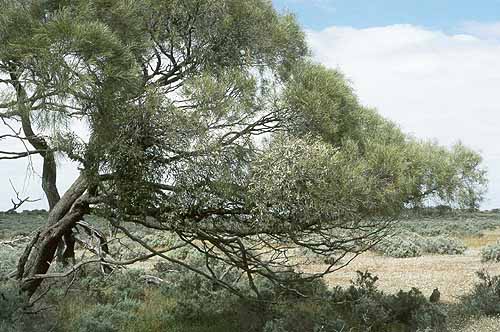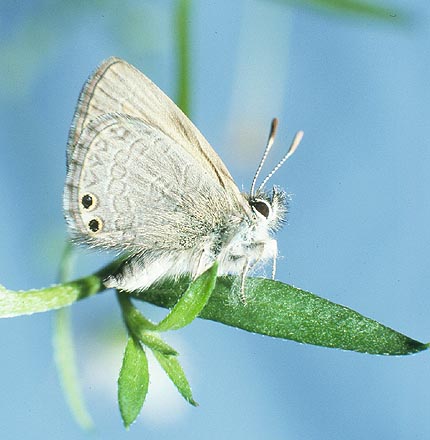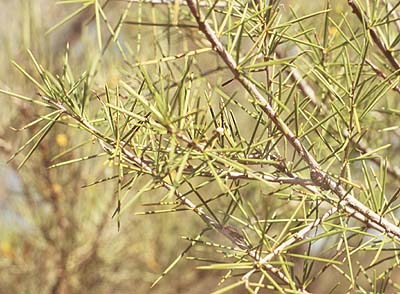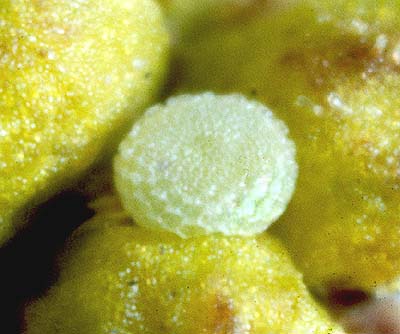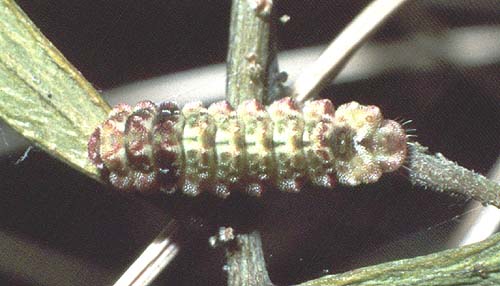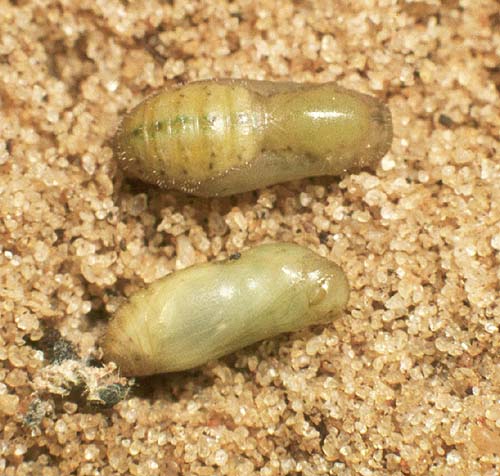-
Larval Food Host
-
Probably most species of Acacia (wattles) (Mimosaceae).
Those wattles actually recorded include
A. anceps (Port Lincoln wattle),
A. aneura aneura (mulga),
A. brachybotrya (grey mulga),
A. calamifolia (wallowa),
A. cyclops (western coastal wattle),
A. erinacea (prickly wattle),
**A. decurrens (early black wattle),
A. iteaphylla (Flinders Range wattle),
A. ligulata (umbrella bush or sandhill wattle),
A. longifolia sophorae (coastal wattle),
*A. karroo, A. mearnsii (black wattle),
A. melanoxylon (blackwood),
A. murrayana (sandplain wattle),
A. nematophylla (coast wallowa),
A. oswaldii (miljee or umbrella wattle),
A. papyrocarpa (sowdenii) (western myall),
A. pycnantha (golden wattle),
A. quornensis (Quorn wattle),
A. retinodes (Wirilda),
A. rigens (needle wattle),
A. rupicola (rock wattle),
A. salicina (native willow or coobah),
**A. saligna (golden-wreath wattle),
A. sclerophylla (hard-leaf wattle),
A. simmonsiana,
A. stenophylla (river cooba),
A. tetragonophylla (dead finish),
A. triquetra,
A. victoriae victoriae.
The larvae usually eat only the mature flower buds and flowers of the wattles,
but sometimes will eat young leaves and the young forming pods or their contained
seeds if the flowers disappear before the larvae have matured.
They prefer the pollen and ovary parts of the small unopened buds.
-
Larval Attendant Ant
-
Larvae are normally attended by a few small black ants Iridomyrmex spp
and in the northern areas also by the large meat ants Iridomyrmex purpureus
and I. viridiaeneus.
-
Eggs
-
Very small, initially pale green, later turning bluish white, hemispherical,
flattened top and bottom, with a small darker central micropylar area on top.
Ornamented with large hexagonal shaped facets on the side, which have a
flattened shape (compressed top and bottom). The facets on the top of the egg
are much smaller and are of irregular shape. Laid singly on the hostplant,
usually on the flower buds, but sometimes on other parts. The eggs hatch in
about five days during spring, decreasing to 3 days in summer, but can take
about 9 days to develop in late autumn. Eggs are sometimes so common on the
green buds as to produce a fine speckled appearance.
-
Larvae
-
The first instar is initially pale yellow, changing colour after eating the hostplant.
There is an indistinct dorsal furrow, and there are transparent peripheral setae (hairs).
Those present laterally are directed downwards, are mostly short (there is an odd long
hair) and strongly flattened, and the ends are distinctly blunt. The hairs present
anteriorly and posteriorly are longer, and are only slightly flattened with pointed ends.
There are paired, mostly very short transparent dorsal setae on each segment that are
flattened and club shaped, and which are flattened against the body and directed
posteriorly. Those present directly behind the head are longer and erect. The head is
dark brown and smooth. As the larvae increase in size, they acquire multicolours, and
dorsal and lateral protuberances, which become better developed with age.
The mature larvae are about 8 mm long. The head is small, smooth, brownish yellow,
hidden beneath the body. Dorsally furrowed, with short blunt paired protuberances
on thoracic segments 2-3 and abdominal segments 1-6, widely spaced near the head,
but gradually coming together towards the posterior end. The lateral edge is strongly
scalloped laterally, being best developed posteriorly, and with each segment triangular
shaped producing a saw-tooth effect. The body has some lateral hairs, which are best
developed on the anterior and posterior parts. It is covered in numerous minute
secondary setae. The larvae are polymorphic (i.e. they occur in many colour forms).
Larvae colour and markings are highly variable and picturesque, being some combination
of green, yellow, orange, pink, purple or brown, with a darker longitudinal dorsal
line and adjacent forward directed chevrons, a hatchured subdorsal line, sometimes
additional lateral markings, and there is often a pale lateral line. The colours
are cryptic and blend in with the buds, flowers and stems of the hostplant, such that
the larvae are virtually invisible to the human eye. Larvae feed openly during the day.
The presence of larvae on the hostplant is discernible by the presence of ants among
the blossom. In the inland areas, larvae often occur in the hundreds on the flowering
hostplants. The larval stage lasts about 4 weeks during spring around Adelaide.
-
Pupae
-
Short cylindrical, mostly smooth, but with short bristles on the abdomen, thorax and
anterior parts, rounded anteriorly and posteriorly, about 6 mm long, polymorphic in
various shades of brown, pink brown, green brown, or even translucent greenish white.
The dark pupae are speckled with darker markings, and there is also a darker broken
dorsal line and two subdorsal rows of black dots along the abdomen. Weakly attached
to the silked substrate by anal hooks and a central girdle.
The larvae usually leave the hostplant to pupate. Most crawl to the base of the hostplant
and pupate on or near near its base. Others simply drop off, or are blown off, then pupate
amidst the old leaf and other debris on the ground beneath the hostplant. If this debris
is sparse then they will pupate beneath rocks, or in cracks or holes in the ground.
Those that choose to pupate on the leaves and amongst the dead blossom of the hostplant
invariably end up on the ground anyway, as their attachment is very weak and the least
interference (from the wind) causes them to detach and fall to the ground. The pupation
period is variable, even within the same population. It can be as short as 6-11 days
during the warm months. It has not been determined if the pupae can aestivate a full year
to coincide with the next season of hostplant flowering. In captivity the pupae always
mature quickly.
-
Flight Period in South Australia
-
It is possible to find flying butterflies throughout the year, depending on the area
and the Acacia hostplant upon which the butterflies have colonised. The larvae
usually only eat the flower buds and flowers of the wattles, and the different species
of wattle bloom at different times during the year. The same species of wattle may
also bloom at different times depending on whether they occur in the north or south of
the state. In the Far North pastoral areas the butterfly is more common after rainy
periods. In the southern temperate areas it is more common during the warmer months,
but it is sometimes seen flying in winter if its hostplant is in bud. The brood period
can be about 6 weeks in temperate areas, but is likely to be much more rapid in the
hotter, northern pastoral areas.

-
Distribution
-
Occurs throughout mainland Australia, including Kangaroo Island, preferring the drier
open woodlands. The butterfly probably has some degree of nomadic dispersal ability
(typical of the Polyommatini group of lycaenids), as their adult morphology is uniform
and they often turn-up in habitat areas in which the hostplant buds are not mature
enough to support the larvae. The butterfly is also found in Indonesia (Lesser Sundas)
and some Pacific islands to east of Australia, but not New Zealand or New Guinea.
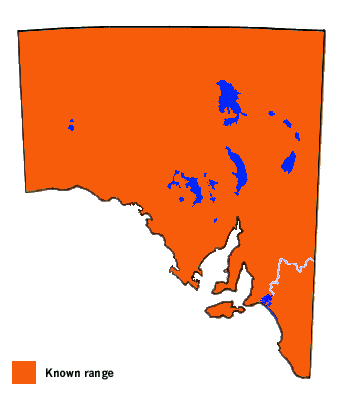
-
Habitat
-
Found wherever its hostplants occur, and these are common and widespread occurring
in most habitats. In South Australia the butterfly is more common in warmer areas,
and tends to be rare in the South Mt Lofty Range and the Lower Southeast in the
cool eucalypt forests.
-
Conservation Status in South Australia
-
Locally common in breeding areas.
-
Threats
-
No major threats.
-
Conservation Strategy
-
None required.



